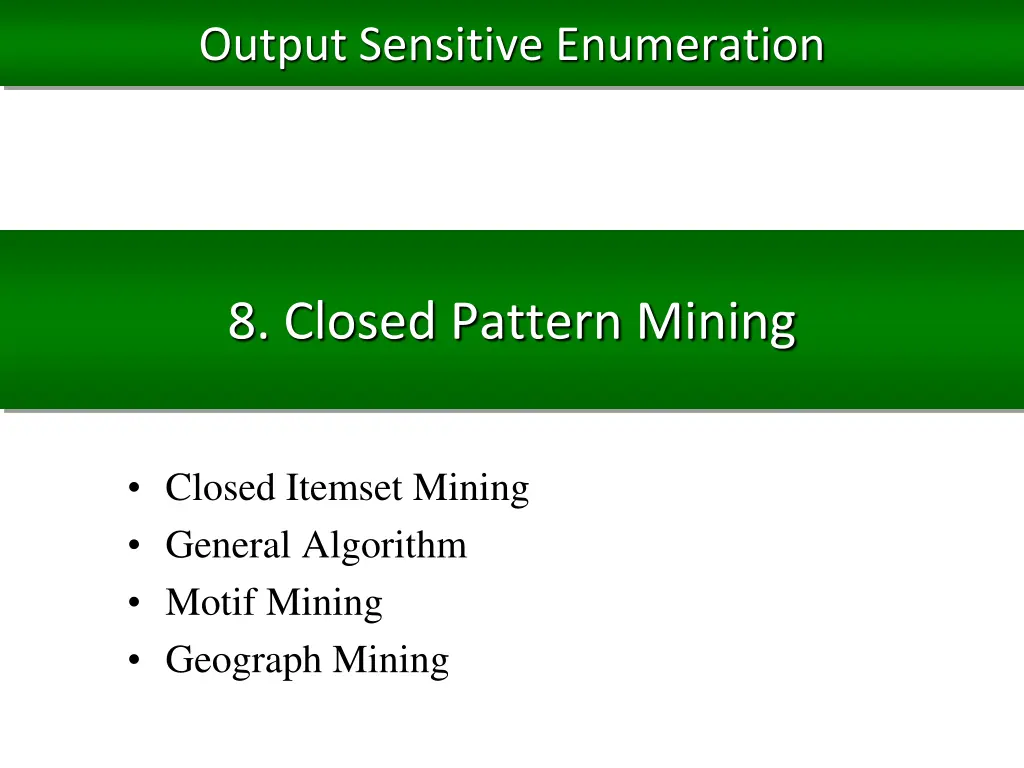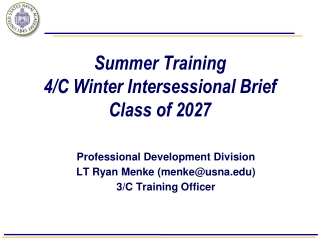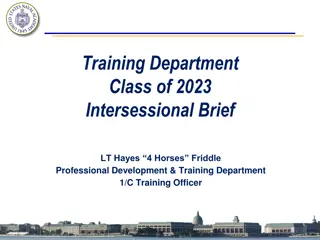
Closed Pattern Mining Techniques: Advantages and Disadvantages
Explore the advantages and disadvantages of closed pattern mining techniques, including output-sensitive enumeration, closed itemsets, maximal frequent itemsets, and more. Learn about the challenges involved in finding interesting frequent itemsets and how to classify them based on occurrence sets. Discover the concept of maximal closed itemsets and their significance in data mining algorithms.
Download Presentation

Please find below an Image/Link to download the presentation.
The content on the website is provided AS IS for your information and personal use only. It may not be sold, licensed, or shared on other websites without obtaining consent from the author. If you encounter any issues during the download, it is possible that the publisher has removed the file from their server.
You are allowed to download the files provided on this website for personal or commercial use, subject to the condition that they are used lawfully. All files are the property of their respective owners.
The content on the website is provided AS IS for your information and personal use only. It may not be sold, licensed, or shared on other websites without obtaining consent from the author.
E N D
Presentation Transcript
Output Sensitive Enumeration 8. Closed Pattern Mining Closed Itemset Mining General Algorithm Motif Mining Geograph Mining
8-1. Closed Itemset
Disadvantage of Frequent Itemset To find interesting(deep) frequent itemsets, we need to set small numerous solutions will appear Without loss of information, we want to shift the problem (model) 1. maximal frequent itemsets included in no other frequent itemsets 111 1 Pasquier et al. 99 2. closed itemsets maximal among those having the same occurrence set 000 0
Ex) Maximal Frequent / Closed Itemsets Classify frequent itemsets by their occurrence sets A: 1,2,5,6,7,9 B: 2,3,4,5 C: 1,2,7,8,9 D: 1,7,9 E: 2,7,9 F: 2 included in at least 3 {1} {2} {1,7} {1,9} {2,7} {2,9} {1,7,9} {2,7,9} {7} {9} D {7,9} frequent closed A closed itemset is the intersection of its occurrences maximal frequent
Advantage and Disadvantage maximal existence of output polynomial time algorithm is open fast computation is available by pruning like maximal cliques few solutions but sensitive against the change of closed polynomial time enumeratable by reverse search discrete algorithms and bottom-wideness fasten computation no loss w.r.t occurrence sets no advantage for noisy data (no decrease of solution) Both can be enumerated O(1) time on average, 10k-100k / sec.
Bipartite Graph Representation Items and transactions are vertices, and the inclusion relations are the edges 1 2 3 4 5 6 7 8 9 A: 1,2,5,6,7,9 B: 2,3,4,5 C: 1,2,7,8,9 D: 1,7,9 E: 2,7,9 F: 2 D A B C D E F itemset and transactions including it bipartite clique of the graph itemset and its occurrence set bipartite clique maximal on the transaction side closed itemset and its occurrence set maximal bipartite clique
From Adjacency Matrix See the adjacency matrix of the bipartite graph 1 2 3 4 5 6 7 8 9 A 1 1 B 1 1 1 1 C 1 1 D 1 E 1 F 1 A: 1,2,5,6,7,9 B: 2,3,4,5 C: 1,2,7,8,9 D: 1,7,9 E: 2,7,9 F: 2 1 1 1 1 D 1 1 1 1 1 1 1 S = {1,7} itemset and transactions including it a submatrix all whose cells are 1
Methods for Closed Itemset Enumeration Based on frequent itemset enumeration enumerate frequent itemsets, and output only closed ones can not get advantage of fewness of closed itemsets CHARM: ZAKI et al. 02 Storage store all solutions found, and use them for pruning pretty fast memory usage is a bottle neck pruning Reverse search computation is efficient no memory for previously found solutions database reduction LCM LCM: Uno et al. 03
Neighbor Relation of Closed Itemsets Remove items from a closed itemset, in decreasing ordering At some point, occurrence set expands Compute the closed itemset of the expanded occurrence set The obtained closed itemset is the parent (uniquely defined) Frequency of the parent is always larger than the child, thus the parent-child relation is surely acyclic The parent-child relation induces a directed spanning tree
Reverse Search Parent-child relation induces a directed spanning tree DFS search on the tree can find all solutions Enumeration method for all children of a parent is enough to search If children are found polynomial time on average, output polynomial (child is obtained by adding an item to the parent) Acyclic relation and polytime children enumeration are sufficient to polytime enumeration of any kind of objects
Ex) Parent-child Relation All closed itemsets of the following database, and the parent-child relation 2 7,9 1,2,5,6,7,9 2,3,4,5 1,2,7,8,9 1,7,9 2,7,9 2 1,7,9 D 2,5 2,7,9 1,2,7,9 2,3,4,5 Move by adding an item Parent-child (ppc extension) 1,2,7,8,9 1,2,5,6,7,9
Computing the Children Let e be the item removed most recently to obtain the parent By adding e to the parent, its occurrence set will be the occurrence set of the child A child is obtained by adding an item and computing the closed itemset However, itemsets obtained in this way are not always children Necessary and sufficient condition to be a child is no item appears preceding to e by closure operation (prefix preserving closure extension (ppc-extension))
Database Reduction We want to reduce the database as frequent itemset enumeration However, can not remove smaller items (than last added item e) computation of ppc extension needs them However, + if larger items are identical, included in Occ at the same time + so, only the intersection of the smaller parts is needed store the intersection of transactions having the same large items intersection is 2, 6,7 The intersection of many transactions has a small size no much loss compared with large
Cost for Comparison We can simply compute the intersection of Occ(S e), but would be redundant. We do just checking the equality of the intersection Occ(S e) and S , thus no need to scan all We can stop when we confirmed that they are different Trace each occurrence of S e in the increasing order, and check each item appears all occurrences or not 4 11 S 3 3 6 9 9 6 4 4 11 1 3 4 5 9 1 3 4 5 9 11 If an item appears in all, check whether it is included in S or not Occ(S e) 2 4 5 9 3 4 5 9 11 1 1 2 4 6 9 2 4 6 9 11 Proceed the operations from the last operated item 1 4 9 1 4 9 11
Using Bit Matrix Sweep pointer is a technique for sparse style data. We can do better if we have adjacency matrix But, adjacency matrix is so huge (even for construction) Use adjacency matrix when the occurrence set becomes sufficiently small By representing the matrix by bitmap, each column (corresponding to an item) fits one variable!
O(1) Time Computation of Bit Matrix By storing the occurrences including each item by a variable, we can check whether all occurrence of S e includes an item or not in O(1) time Take the intersection of bit patterns of Occ({i}) and Occ(S e) If i is included in all occurrences of S e, their intersection is equal to Occ({i}) Occ({e}) Occ(S)
8-2. Result of Competition
real-world data (sparse) average size 5-10 BMS- WebView2 BMS-POS retail
real-world data (sparse) memory usage BMS- WebView2 retail BMS-POS
dense (50%) structured data pumsb connect chess
dense structured data, memory usage pumsb connect chess
dense real data large scale data accidents accidents memory web-doc
8-3 Closed Pattern in General
Another Definition Closed patterns can defined in another way; closed pattern maximal in those having same occurrence set Then, in some poset, we have many maximals, thus closed pattern is not uniquely defined If the poset is a lattice, the maximal is unique (join) Moreover, the maximal has the same occurrence set, if the lattice is distributive Closed pattern is defined by the meet of the occurrence set (so, uniqueness of join is not necessary)
Cases that dont work + Sequences A B C D A C B D + graphs (even rooted trees) Usually, if occurrence is determined when matching of one (or few) entity is determined, and not if not Occ can be exp.
Problem Setting Closed pattern enumeration: For given a set of elements y1, ,ym of a distributive lattice, enumerate all the elements that are the meet of some S {y1, ,ym} (Closed pattern is the maximal element included in all occurrences meet of the occurrences) For an element z, yi s.t. z yiis an occurrence, and meet of the occurrence set is the closure
Proof The maximal has the same occurrence set, if the lattice satisfies that the meet is uniquely defined (more general than distributive) When xi yj holds for any x1 ,xk and y1, ,yh, the meet z of y1, ,yh satisfies xi zfor any xi the definition of meet is maximal among all z s.t., z {y1, ,yh} Any xi satisfies the condition, thus xi z
Extension For the enumeration, we need a method to make a closed pattern from another For an element x (pattern), we compute the occurrence set then, their meet is the closed pattern (closure operation) For the meet, every its successor has a different occurrence set By applying the closure operation, we can get a new closed pattern (closure extension)
Completeness of Extension For an occurrence set X, consider a maximal set Y, included in X and has its meet different from X The meet Y of Y satisfies Y xi for any x1 ,xk at least one successor of Y (in the path from Y to X) has its occurrence set equal to X at the closure of the successor is X any meet can be obtained from another smaller meet
Enumeration Framework Start the search (enumeration) from the minimal elements pattern mining is hard if the minimal are hard to enumerate ClosedPatternMiningOnDisLattice (S) 1. mark{S} = 1; output S 2. for eachsuccessor S of S 3. S == Occ(S ) 4. if mark{S } == 0 & frq(S ) then call ClosedPatternMiningOnDisLattice (S ) 5. end for
Complexity Each iteration takes time for computing successor, occurrence set, and the meet of the occurrence set the computation time for one iteration is given by these (# of successors (occurrence, meet)) if all these are polynomial time, then polynomial delay (same as one iteration, by alternative output) Space is required to store all the solutions already found in memory Exponential space in general
Reverse Search Sophisticated Define the parent of a closed pattern in a sophisticated way Go down to a lower area (by adding a record of the data to the occurrence set and take the meet) Go up until just below the original area (by following the path to the original pattern by iterative closure extensions) In this way, we can define the parent uniquely, and it is computable in polynomial time (If I m not your parent, I don t make you!) polynomial space!
PPC Extension Needs More In PPC extension, we remove the items from larger one, and obtain an itemset with larger occurrence set this is equivalent to the lattice version Then, we don t have to climb up, since by adding the vertex removed last, we get the original occurrence set this differs from the lattice version!
PPC Extension Needs More In itemset version, the vertex removed last can be added to other pattern always, and then it it restricts the occurrence to the original occurrence The item works well; it recovers the original occurrence set, if the prefix is preserved The patterns having similar item-like structures, we can develop ppc-extension type algorithms
8-4. Closed Motifs
Motivated by Bioinformatics In genome analysis, some genome sequences represent the same function (meaning), but have different sequence (string) Even each amino acid is made from different three letters The third letter often doesn t matter so, some genome sequences should be represented like 1 letter AT TT CG
General Setting (called motif ) In general, we want find patterns of this type AT TT ( is called wildcard , and other letters solid letters ) A solid letter x matches only x A wildcard match any solid letter and CCGCC G A motif S matches a position of another motif (or string) if any ith letter of S matches the ith letter of the substring starting from the position AT GTGCC TT CCGCC GT C GTCC G
Problem Formulation Our problem is to find all motifs appearing at least times in the given string data (one long, or many short) ATGCCGACCC appear at least twice in A, T, G, C, CC, A C, G C There are two ways to count the appearance; document occurrence # of strings (motifs) of the database that the motif matches position occurrence # of (position i, strings T) to which the motif matches
Enumeration Framework The empty string is the start point ( ) matches to everywhere Then, change (they are successors) to some letter, and motif becomes more complicated specified AA AB A A A A A B A B general
Enumeration Framework For a motif S, let S(i, x) be the motif obtained from S by replacing its ith letter to x, if ith letter is , and S itself otherwise Let tail(S) be the position of the last letter that is not For avoiding duplications, change letters after the last solid letter MotifMining (S) 1. output S 2. for each (i,x), s.t. i>tail(S) 3. if frq(S(i,x)) then call MotifMining (S ) 4. end for
Motif has Meet For a set of motifs we can get the most specified motif (corresponding to their meet) ATCGTTGC ATCGCCGCGG ATC G CCGCCGC CCGCCGCTG TAGCAA CCGTAGCAG C GC Computed in O( (# of motifs) (length) )
PPC Extension When ith letter of S is specified motif unless it is already changed to a solid letter (this is item-like property ) , it can be changed in any more A AA C T + Change the last solid letter to wildcard, one by one + At some point, occurrence set expands + Then, take the closure (meet) The prefix part doesn t change, and some latter solid letters will recover
PPC Extension When ith letter of S is specified motif unless it is already changed to a solid letter (this is item-like property ) , it can be changed in any more A AA C T + Change the last solid letter to wildcard, one by one + At some point, occurrence set expands + Then, take the closure (meet) The prefix part doesn t change, and some latter solid letters will recover
PPC Extension When ith letter of S is specified motif unless it is already changed to a solid letter (this is item-like property ) , it can be changed in any more A AA C + Change the last solid letter to wildcard, one by one + At some point, occurrence set expands + Then, take the closure (meet) The prefix part doesn t change, and some latter solid letters will recover
PPC Extension When ith letter of S is specified motif unless it is already changed to a solid letter (this is item-like property ) , it can be changed in any more A AA + Change the last solid letter to wildcard, one by one + At some point, occurrence set expands + Then, take the closure (meet) The prefix part doesn t change, and some latter solid letters will recover
PPC Extension When ith letter of S is specified motif unless it is already changed to a solid letter (this is item-like property ) , it can be changed in any more A A + Change the last solid letter to wildcard, one by one + At some point, occurrence set expands + Then, take the closure (meet) The prefix part doesn t change, and some latter solid letters will recover
PPC Extension When ith letter of S is specified motif unless it is already changed to a solid letter (this is item-like property ) , it can be changed in any more A A C + Change the last solid letter to wildcard, one by one + At some point, occurrence set expands + Then, take the closure (meet) The prefix part doesn t change, and some latter solid letters will recover
Listing Children To obtain the one s children, we change each wildcard each solid letter, compute the closure, and check the ppc condition , to A AA C If the prefix part doesn t change (prefix preserving), then the result is a child For each wildcard at ith position, we can compute the occurrence sets of the motifs s.t. it is changed to each solid letter, by delivery 25 64 1 20 47 87 Occ = {1, 20, 25, 47, 64, 87} A T G C O(|max. pattern length| |Occ|)
Closed Pattern Enumeration Naturally, the following algorithm is obtained ClosedMotifMining (S, j) 1. output S 2. for each (i,x), s.t. i>j 3. compute Occ(S(i,x)) 4. compute the meet S of Occ(S(i,x)) 5. if frq(S(i,x)) then call ClosedMotifMining (S , i) 6. end for (|max. pat. len.| |Occ(S )|) = |Occ(S)| Each iteration takes O(|max. pat. len.| O(|max. pat. len.| O(|max. pat. len.|2 |Occ(S)|) for occurrence computation |Occ(S )|) for meet computation |Occ(S)|) time in total
8-5. GeoGraphs






















